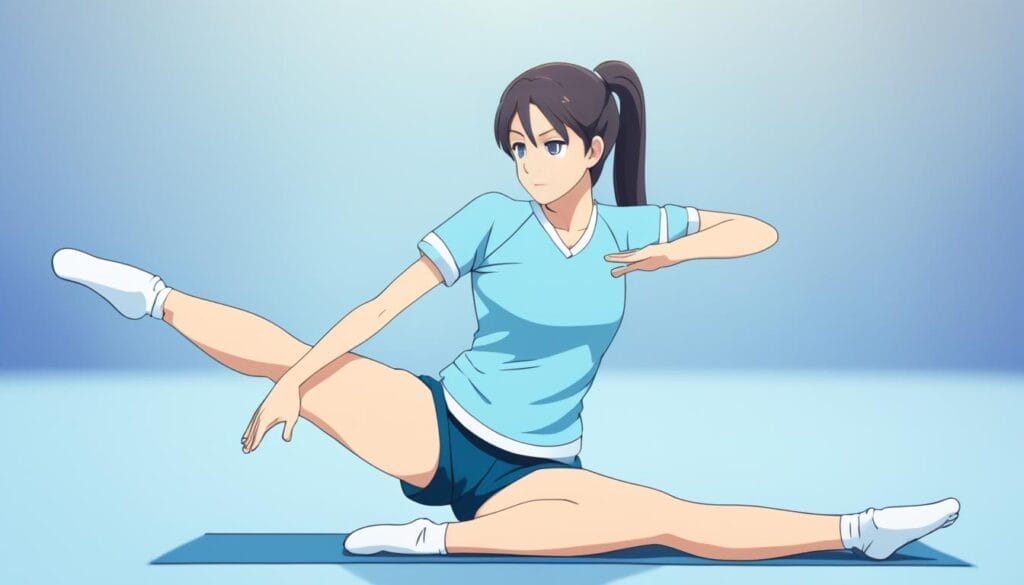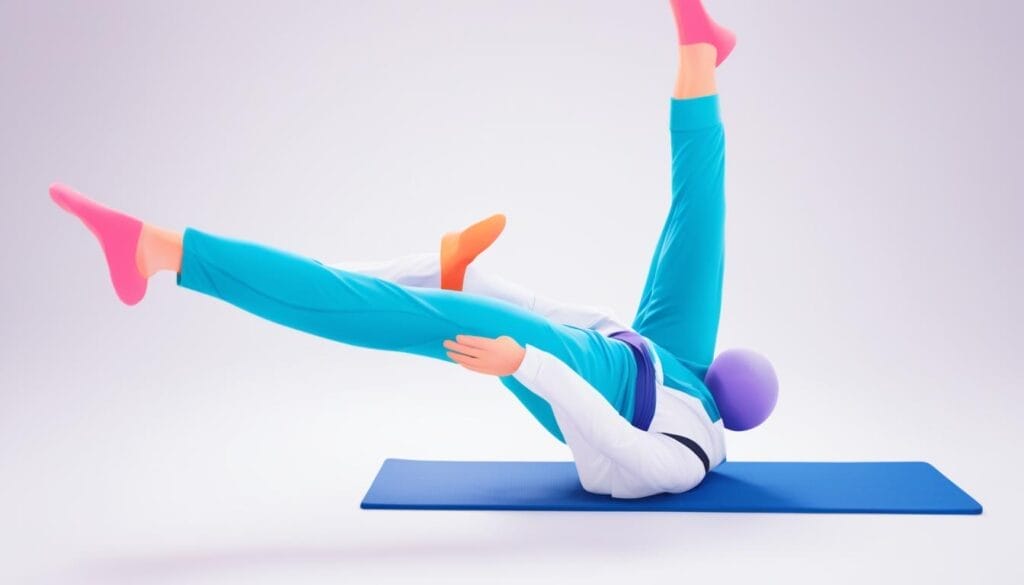Have you ever started a new workout routine, only to get hurt soon after? It’s frustrating, right? I know how it feels. The joy of getting fit fades quickly. Instead, you’re faced with disappointment and delays.
I’ve got some essential tips on how to boost flexibility and injury prevention. These tips have kept me safe and made exercising more enjoyable. They might be just what you need to up your exercise game without the worry of getting hurt.
So, these tips are for anyone who loves to work out or is just getting started. They’ll help you stay injury-free and have fun staying active. Let’s get started with these game-changing suggestions!
Key Takeaways:
- Flexibility and injury prevention are essential for a safe and enjoyable workout experience.
- Regular stretching exercises, such as yoga and pilates, can improve joint mobility and reduce the risk of injury.
- Incorporating strength exercises, like lifting weights and working with resistance bands, can increase muscle strength and reduce joint pain.
- Proper warm-up, cool-down, and listening to your body are crucial for injury prevention.
- Following these tips will help you maintain flexibility, prevent injuries, and continue enjoying an active lifestyle.
Strength Exercises for Injury Prevention
Including strength exercises in your routine is key to avoid injuries. These activities push your muscles to get stronger. This makes you stronger, more powerful, and able to do more without getting hurt. Working out this way makes you fitter, lowers injury chances, and boosts your performance.
There are many ways to strengthen your muscles. You can:
- Lift weights
- Use resistance bands
- Do heavy gardening
- Climb stairs
- Ride a bike
- Join dance classes
- Perform push-ups, sit-ups, and squats
- Try out yoga
For the best results, aim to do these exercises twice a week. It’s vital to work all your major muscle groups to stay balanced. As you get stronger, you should also increase how hard you exercise. This way, you keep challenging your muscles and growing stronger.
Doing a mix of strength exercises is a good plan. It keeps your muscles healthy, which lowers your injury risk. Plus, you get fitter because you’re hitting all parts of your body.
Starting any new workout needs a chat with an expert. This could be a doctor or a fitness coach. They teach you the right way to exercise. They also help you slowly get stronger, without getting hurt.
“Strength exercises are crucial to staying safe from injuries and feeling fit. They make your muscles strong, improve how you balance, and lower the chance of getting hurt. Mixing up your workouts can really boost your health.”
So, it doesn’t matter if you like lifting weights, doing yoga, or something else. Just make sure you focus on getting stronger. This way, you keep injuries at bay and enjoy feeling more active and well.
| Strength Exercises | Description |
|---|---|
| Lifting weights | Involves using dumbbells or barbells to perform exercises targeting specific muscle groups. |
| Resistance bands | Elastic bands that provide resistance as you perform exercises, helping to strengthen muscles. |
| Heavy gardening | Activities like digging, lifting, and carrying heavy objects in the garden can be a great way to work your muscles. |
| Climbing stairs | A simple and effective way to engage your leg muscles, build strength, and improve cardiovascular fitness. |
| Cycling | A low-impact exercise that strengthens the lower body muscles and improves cardiovascular health. |
| Dance | Different dance styles, such as ballet or hip-hop, can help tone and strengthen various muscle groups. |
| Push-ups, sit-ups, squats | Bodyweight exercises that target multiple muscle groups and promote overall strength and stability. |
| Yoga | A combination of poses and movements that enhance strength, flexibility, and body awareness. |
Flexibility Exercises for Injury Prevention
Flexibility exercises are key for stopping injuries. They make our joints move better and help us do more everyday and sports. These exercises make our posture better, stop aches, and lower our injury chance.
We should mix various flexibility exercises into our day. For example, you can try:
- Stretching: Stretching makes muscles more flexible. It allows our joints to move further. Do it before or after you work out, or on its own. Yoga and pilates have different stretches for every muscle group. They boost your flexibility all over.
- Yoga: Yoga mixes stretching with breathing and focus. It increases flexibility, strength, and balance. Doing yoga poses often also helps you relax and lessens injury risks.
- Tai Chi: Tai chi is a soft martial art with slow moves and deep breaths. It focuses on being flexible, balanced, and coordinated. Doing tai chi can make your joints more flexible, your muscles stronger, and you feel better.
- Pilates: Pilates is gentle and builds your core, flexibility, and alignment. It’s about controlled moves that work on specific muscles. It makes you more flexible and helps your posture.
Not everyone agrees on how much you should do these exercises. But, working on them regularly has lots of good outcomes. You might only stretch a few minutes a day, or take yoga or pilates classes. The aim is to find what works best for you. This can make your body feel better overall.
Don’t forget, keeping flexible is super important. It helps avoid injuries and do well in whatever you like to do. These exercises will make your joints better, lower injury risks, and make you more flexible. Plus, you’ll find you enjoy the benefits of being ‘slinky’.

Benefits of Strength and Flexibility Activities
Doing strength and flexibility exercises has many upsides for your health. They help with keeping fit and make daily life better. By doing these exercises, you gain a lot, like stronger muscles and being more flexible.
Improved Physical Performance
Strength and flexibility activities can boost how you move. They help your muscles get bigger and stronger. This makes things like lifting stuff or walking upstairs feel easier.
Maintained Ability for Everyday Tasks
As you get older, you might find it harder to do regular things. This is because muscles and bones weaken over time. However, working out can help slow this down. You’ll find it easier to do the things you need to, like carrying shopping or going up steps.
Reduced Risk of Falling
These activities also make you less likely to fall. Falls can really hurt people, especially the elderly. But by doing exercises that make your muscles strong, like squats or yoga, you improve balance. This reduces your chances of falling.
“Adding muscle-strengthening exercises to your week cuts the risk of falling, letting you keep living life independently.” – Physiotherapy Today
Improved Posture
Flexibility exercises, like stretching, can fix your posture. They help relax tight muscles and make joints more mobile. This means you stand and sit up straight. Good posture makes you look confident and stops aches and pains.
Achieve a Healthier Lifestyle
By adding these exercises to your routine, you can live better. They help not just your body but also make your mind happier. Moving more releases feel-good chemicals, which lower stress and worry. Plus, sleeping and managing your weight could get better too.
Keeping at these exercises regularly pays off in many ways. You’ll see better physical performance and a lower risk of falling. Plus, your posture will be better, and you’ll live a healthier life overall. These benefits are key to a long-lasting and enjoyable routine.
| Benefits of Strength and Flexibility Activities |
|---|
| Improved Physical Performance |
| Maintained Ability for Everyday Tasks |
| Reduced Risk of Falling |
| Improved Posture |
| Achieve a Healthier Lifestyle |
Tips for Effective Stretching
Stretching is key for preventing injuries. It improves how flexible you are, lessens injury chances, and boosts performance in sports. For the best results, it’s crucial to follow certain rules when stretching.
Warm-up before stretching: Always start by warming up. Doing light activities, like jogging or jumping, gets your blood flowing. This makes your muscles ready for stretching.
Focus on major muscle groups: It’s vital to work on big muscle groups. These are areas like the hamstrings, quads, and back. By stretching these parts, you’ll get more flexible and reduce muscle problems.
Avoid bouncing: Bouncing or jerky movements during stretching are a no-go. Instead, move smoothly into each stretch and hold it for 30 seconds. This way, your muscles can loosen up, making the stretch more effective.
Don’t push to the point of pain: Stretching should feel good, not painful. Always stop if it hurts or feels too much. It’s about being gentle with your body to prevent injuries.
Stretch regularly: Doing stretches a few times a week is best. This helps you get more flexible over time. Plus, it keeps all the great benefits of stretching going.

Stick to these important tips when you stretch. They will help you get the most out of your routine. Better flexibility, less risk of injury, and better sports performance are just a few of the benefits you’ll see. Remember to warm up, focus on big muscle groups, skip the bouncing, stay gentle, and be consistent in your stretching.
| Benefits of Stretching | Improve Range of Motion | Decrease Risk of Injury | Stretching Essentials |
|---|---|---|---|
| Enhanced Flexibility | Enhanced Joint Mobility | Improved Muscle Function | Regular Stretching Routine |
| Reduced Muscle Stiffness | Injury Prevention | Controlled Stretch Duration | Muscle Warm-up |
| Improved Posture | Better Performance | Gentle and Smooth Stretching | Avoiding Excessive Force |
Injury Prevention Tips for Workouts
Staying injury-free during your workout is a must. By knowing a few key tips, you can cut down on the risk of harm. This way, you’ll keep loving your fitness journey. Here’s what you need to do:
1. Warm up and cool down:
Always kick off your session with a good warm-up. Do light exercises to get your blood pumping and muscles loose. And, after you’re done, cool down with some easy stretches to help your body recover.
2. Incorporate dynamic stretching:
Adding dynamic stretching to your routine is a smart move. It means moving your joints and muscles like you mean it. This type of stretching can boost your flexibility, increase blood flow, and help you perform better.
3. Ease into a new workout:
Starting something new should always be slow. Let your body get used to it step by step. This approach ensures you avoid overdoing it and lower injury chances.
4. Try cross-training:
Switching up your exercises is a good way to stay injury-free. When you do various activities, different muscle groups get involved. And, it allows your used muscles to take a break.
5. Listen to your body:
Listening to your body is vital. If something hurts during a workout, stop or change what you’re doing. Giving your body a break when it needs it is crucial for a safe workout.
6. Dress right:
Wearing the right gear is more important than you think. Pick clothes and shoes that fit well and support your feet. This way, you’ll avoid accidents and stay safe while working out.
7. Take rest days:
Don’t skip rest days. They help your body heal and grow stronger. Always plan for rest in your fitness routine to avoid burnout and long-lasting injuries.
Follow these flexibility and injury prevention tips closely to keep moving without worry. Remember, taking good care of your body is the key to reaching your fitness dreams.

Conclusion
Keeping active and avoiding injuries are vital. Add both strength and flexibility exercises to your routine. Always stretch correctly and be careful during workouts. This will lower your injury risk and let you enjoy staying active.
Start your exercise journey slowly and move at your own speed. Rest and let your body heal. This is crucial for your muscles and joints. With the right approach, you’ll keep flexible and prevent injuries.
Preventing injuries is something you work on always. Stay with your routine, pick activities that make you happy, and know your limits. By doing this, you’ll keep fit, stay healthy, and chase your fitness dreams with joy.
FAQ
What are some examples of strength exercises for injury prevention?
Strength tasks can be lifting weights, using resistance bands, or heavy gardening. Climbing stairs, cycling, dance, push-ups, sit-ups, squats, and yoga also count.
What are some examples of flexibility exercises for injury prevention?
Flexibility actions are stretching, yoga, and tai chi. Pilates is also a great choice.
What are the benefits of strength and flexibility activities?
Building up muscles helps you do daily things easily. It also cuts the chance of falling. Plus, it slows down muscle and bone loss as you get older. Getting more flexible enhances how you stand, lowers pain, and decreases injury risks.
How can stretching help with injury prevention?
Stretching makes your movements wider. This cuts the chance of getting hurt. It also makes you better at physical activities.
What are some tips for effective stretching?
To stretch properly, first warm up your muscles. Then, focus on the main muscle groups. Move smoothly without bouncing. Hold each stretch for about 30 seconds. Don’t go so far that it hurts. Do this regularly, at least two or three times a week.
What are some injury prevention tips for workouts?
To stay safe during workouts, warm up and cool down well. Do dynamic stretching to get more flexible before and after. Start any new activity slowly. Increase the effort and time little by little. Change your exercises and do different types to avoid stress on your body. Always listen to how your body feels, wear the right clothes, and take breaks when your body tells you to.
How do flexibility and injury prevention go hand in hand?
Doing activities that build strength and stretch keep you from getting hurt. This keeps you safe and lets you enjoy being active.
Source Links
Share Me:
READY TO UNLEASH
YOUR BEST SELF?
Click “Sign Me Up!” And Start Your Fitness Transformation!





